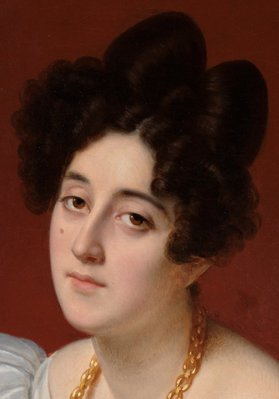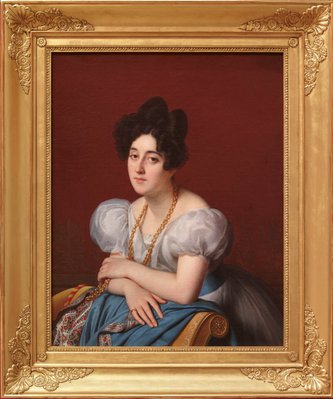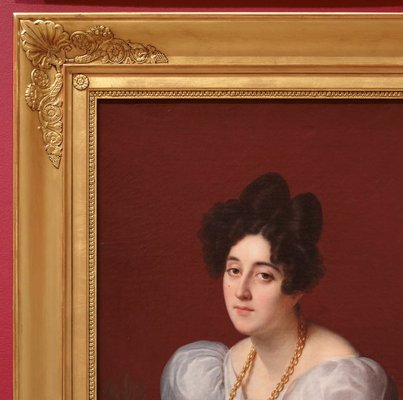Title
Portrait of a young woman leaning on a meridienne
1828
Artist



-
Details
- Other Titles
- Portrait d’une jeune femme portant une robe blanche, avec un châle de cachemire, accoudée à une méridenne
Portrait de l'artiste accoudée à une méridenne - Alternative title
- Portrait d’une jeune femme accoudée à une méridenne
- Date
- 1828
- Media category
- Painting
- Materials used
- oil on canvas
- Dimensions
- 90.8 x 71.8 cm image; 92.3 x 73.9 cm stretcher; 119.8 x 100.5 x 11.5 cm frame
- Signature & date
Signed and dated in black oil, l.l. "Louise Hersent 1828".
- Credit
- Art Gallery Society of NSW 2022
- Location
- South Building, ground level, Grand Courts
- Accession number
- 215.2022
- Copyright
- Artist information
-
Louise Hersent
Works in the collection
- Share
-
-
About
Louise Marie-Jeanne Hersent, née Mauduit, was born in Paris in 1784, the daughter of geometry teacher and architect Antoine-René Mauduit (1731–1815). She studied with two famous neo-classical painters, learning how to paint historical and mythological scenes, firstly with Guillaume Léthière (1760–1832), and then with Charles Meynier (1763–1832), quickly becoming his best-known pupil. She regularly exhibited genre and history paintings as well as portraits at the Salons from 1810 to 1824. She was awarded a 1st class medal at the 1819 Salon with an important historical scene commissioned by King Louis XVIII, 'Queen Henrietta Maria lands on the French coast' (Musée du Louvre, on deposit in Dinan).
In 1821, Louise Mauduit married the painter Louis Hersent (1784–1862), a disciple of Jacques-Louis David (1748–1825). In 1822, the couple purchased a large studio in 22 rue Cassette, in the centre of Paris, where Louise opened a painting studio for women artists. At the end of the 18th century, a small number of workshops that welcomed women artists who were not born into artistic families began to open. In subsequent years, increasing numbers of women, including Louise Hersent, Pauline Auzou and Hortense Haudebourt-Lescot, opened dedicated studios. Hersent’s studio was later run by her disciple Louise Adélaïde Desnos (1807–78), who painted a beautiful portrait of her teacher in 1835 (today at the Musée national du Château de Versailles). Such studios acted as spaces of transmission where women were taught technical and professional skills, but also where they could share their experiences and refine their strategies to distinguish themselves in the artistic context of the time. In certain studios, women were even taught the same curriculum (including the nude and history painting) as their male counterparts.
Louise Hersent achieved great success as history painter (ranked as the top of the hierarchy of genres by the Académie des Beaux-Arts). Under the Bourbon Restoration (1814–30), Paris offered history painters impressive possibilities for state patronage. Several paintings Hersent exhibited at the Salon, including 'The visit of the Duke of Sully to the Queen on the day after the death of Henri IV' in 1822 and 'Louis XIV blessing his great-grandson' (Rennes, Musée des Beaux-Arts) in 1824, were immediately purchased by the Royal Administration. Her husband's official position as a member of the Académie may have favoured her official recognition. Subsequently, under the new regime of Louis-Philippe, Hersent was commissioned in 1838 to produce a large painting depicting an unfamiliar episode of King Louis XV’s reign for the Musée historique de Versailles for the sum of 3000 livres ('Louis XV visits Peter The Great in the Hôtel Lesdiguières', sent to Dieppe in 1876).
Concurrent with her success as an official history painter, Hersent maintained an important practice as a portraitist, and her portraits were praised by a number of Salon critics. In 1824, writer and critic August Jal recalled Hersent “as a portraitist, under the name of Miss Mauduit, who, in the arts, has already made a renowned name for herself […] and deserves all our attention”. Louise Hersent died on 7 January 1862, only 14 months after her husband. They are both buried at the cemetery of Père Lachaise in Paris.
The present work shows an unidentified young woman of French high society, leaning casually, arms crossed, on the side support of a beige velvet 'méridienne' – a sofa typical of the Empire period. On the furniture is thrown a bright, blue-coloured Indian cashmere shawl with a woven pattern down the sides and a deep border depicting the popular (and then incorrectly known) ‘Paisley’ design. Rare and sought after, shawls were made from expensive raw materials. They became an essential fashion accessory for European women from the end of the 18th century and the perfect complement to the dresses then in vogue – ‘the elegance of a women can be equated with the quality of her shawl, or rather, of its price’, stated the 'Journal de Paris' in 1805.
The sitter wears a typical neo-classical dress, in fine cotton, fastened under the bust, with short, semi-transparent muslin sleeves and a plain, low neckline. The simplicity of the dress spoke of Greek heroic times and classical virtues, while the blue colour of the shawl and silk belt served to heighten the whiteness of the dress and the lady’s glowing complexion. The model’s feminine appearance is further enhanced by a long heavy gold link necklace which loops over her torso and is unconventionally wedged between her arms, contributing to her uncontrived pose. Hersent convincingly rendered the varying textures of fabric and flesh to create a smooth surface with little visible brushwork. This skilful depiction along with the stylised contours of the sitter’s body, her elongated fingers and extravagant curled hairstyle arranged in the ultra-fashionable Apollo knot are all reminiscent of Ingres’ dazzling style. And like Ingres in his best portraits, Hersent depicted this elegant ‘woman of the world’ with a remarkable sensitivity and empathy, brilliantly capturing her elusive and singular personality.
-
Exhibition history
Shown in 3 exhibitions
Portrait(s) d’un collectionneur, Villa Vauban, , 02 Dec 2000–04 Feb 2001
Portraits de l’époque romantique – Une passion de collectionneur, Maison de Châteaubriand, France, 29 Apr 2014–10 May 2015
Peintres femmes – Naissance d’un combat 1780–1830, Musée du Luxembourg, Paris, 19 May 2021–25 Jul 2021
-
Bibliography
Referenced in 8 publications
-
Barbara Dabrowa, Look, 'In the frame', Sydney, Jun 2023-Jul 2023, pp 44–46: pp 44, 45.
-
Norbert de Beaulieu, Portraits de l’époque romantique – Une passion de collectionneur (exh cat), Châtenay-Malabry, 2014, p 79, no 7, col illus np.
-
Anne Gérard-Austin, Look, 'Grande dame', Sydney, Jun 2023-Jul 2023, pp 38–43, col illus front cover, p 38 (in situ).
-
Martine Lacas, Peintres femmes – Naissance d’un combat 1780–1830 (exh cat), Paris, 2021, p 200, no 31, col illus p 58.
-
Isabelle Mayer-Michalon, Peintres femmes 1780 – 1830. Naissance d’un combat, Dossiers de l’art, no 286, 'Louise Hersent, née Mauduit', Paris, Mar 2021, p 68, col illus p 68.
-
Danièle Wagener and Norbert de Beaulieu, Portrait(s) d’un collectionneur (exh cat), Luxembourg, 2000, p 63, no 63, col illus p 63.
-
Tableaux anciens (auct cat), Paris, 30 Jan 1989, p 31, no 72, illus p 31.
-
Important tableaux anciens (auct cat), Paris, 18 Dec 1991, no 232.
-
